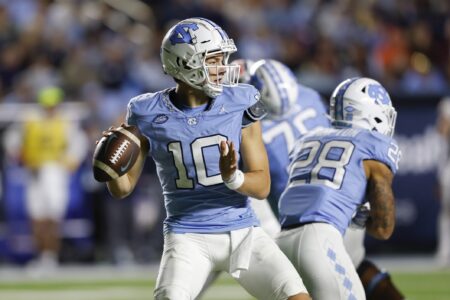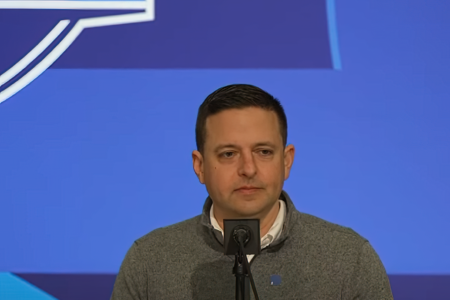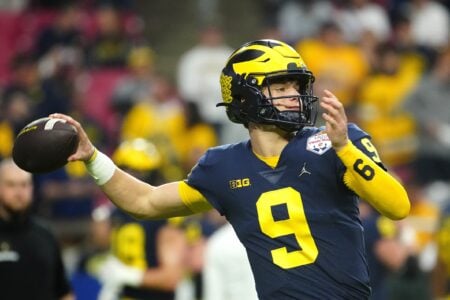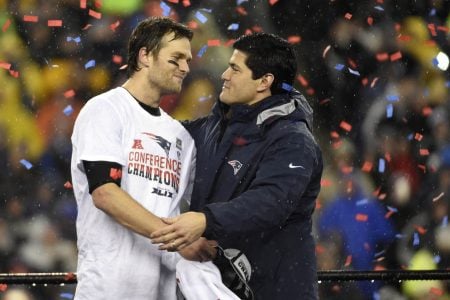Shockt327
Rotational Player and Threatening Starter's Job
- Joined
- Apr 25, 2008
- Messages
- 1,406
- Reaction score
- 656
While doing some reading on Dom Capers approach to installing the 3-4 in Green Bay, I came across an alarming statistic: The Patriots only played their base 3-4 on 150/1000 snaps last season. Wow. Capers also says he plans to play Nickel 50% of the time; which I think applied and will continue to apply in NE too (I wish I had real numbers on the use of each sub-package to back up my point). I know the Pats play a lot of Nickel (with a 4 man line), but this makes me wonder if they do it far, far more than we realize.
Here are my thoughts (feel free to argue or add your own):
Here the article:
Conversion formula - JSOnline
Here are my thoughts (feel free to argue or add your own):
- Capers views the 3-4 as being more of a run defense; which is certainly no shock. Yet, it's becoming more and more of a pass first league. As such, statisticians have been pointing out that run defense is the least important factor in correlation to winning games (more here). I've also heard a few stories about how Belichick pays special attention to advanced statistics and how he has adapted his game based on that info (specifically: going for it on 4th down more often, and passing on 1st down more often, and using the shotgun more often) Bill pays close attention to statistical analysis. I wonder if this is one of the reasons why he's getting away from a 'run first' defense.
- The acquisition of Derrick Burgess makes far more sense in light of this info. In the Nickel, the Pats switch to a 4 man line. On a 4 man line Burgess's role would be no different than that of a 4-3 DE, if I'm not mistaken. That seems to be how he's been used in pre-season; usually lining up in what appears to be a 7-technique, as a LDE. I think he's going to have a bigger role than we initially thought.
- Getting rid of Vrabel also makes sense. Vrabel's pass rushing skills declined in 2008. He could still set the edge in the run game like no other, but as I said above, it seems like NE is putting more of an emphasis on pass rushing.
- Does this also partially explain the Seymour trade? In the Nickel – on a 4 man line - Seymour often moved inside as a DT. To me, it seemed as if Vrabel and Thomas (or Jarvis Green) would mostly play DE. Yet, the Pats have Wilfork, Warren, Brace, Pryor, and Wright. Those guys all project as DTs on a 4 man line. Did that make Seymour more expendable in the eyes of Belichick?
Here the article:
Conversion formula - JSOnline
Indianapolis - Coach Mike McCarthy has heard the scuttlebutt that the Green Bay Packers are just whistling "Dixie" when it comes to fitting the defensive front seven from their old 4-3 defense to a new 3-4 scheme.
As one personnel director put it last week: "You can't automatically say, 'They've got Dom Capers and are going to be a great defense.' You have to have personnel for the defense, and they don't. They've only got 70%, 80% of the puzzle."
McCarthy, however, doesn't come close to seeing things that way.
"I think we're a lot better off than people think we are," McCarthy said over the weekend. "I think people have underestimated us a little bit. I think we've got good depth already."
That would hold especially true at inside linebacker, where McCarthy says the Packers have "five or six that could play right now."
McCarthy also is optimistic about the situation at outside linebacker, where he counts five veterans plus Brandon Chillar, who figures at all four positions.
A personnel director for a team with a 3-4 defense foresees growing pains in Green Bay.
"It's a huge transition for them," the scout said last week. "It will be a chore to adapt that talent to a 3-4 scheme. But the guy (Capers) who is doing it is a good enough coach so he probably will blend in a little 4-3 and not make it a total transition in Year 1. If you can do that, you can survive until you have two or three years to kind of flip the roster."
Just so there's no confusion, McCarthy spelled out, for the first time, some basics of the new scheme.
Unlike New England and Miami, the Packers will not ask their linemen to two-gap. Instead of playing head-up on an offensive lineman and being responsible for the gap on either side, the defensive linemen generally will play to the edge of blockers.
"We'll be more like Pittsburgh and Dallas," McCarthy said. "I'm not going to make Cullen Jenkins stand in there all day and play two-gap. Would you make Cullen Jenkins do that? No. Of course not."
The 3-4 will be what McCarthy termed his "starting point" on defense. At times, he said the Packers would work from a 4-3 "under" front. And depending on the opponent and circumstances, they'll play up to 50% of games in nickel defenses, which McCarthy calls his sub packages.
"Do you know how many snaps of base New England was in last year?" McCarthy said. "Something like 154 or 156 (out of about 1,000)."
McCarthy hopes the 3-4 will cure the Packers' inadequate showing on early downs. Eight of the nine teams using the 3-4 in 2008 ranked among the top half of the NFL in run defense.
"The thing about the 3-4 is, it's better against the run," he said. "There's three bubbles to run at in the 4-3. In the 3-4, you've got five guys on the line of scrimmage and only two bubbles. The whole goal is to get to third and long and into 'sub' quicker, where we're much more athletic.
"I thought the old scheme was outstanding against third down. I thought our issues were more on first and second down."
The outside linebackers will be labeled left outside and right outside. They won't shift against motion.
"You want to play left and right so your tendencies are cut in half," McCarthy said. "If they're left and right, you can roll (coverage) this way or that way."
One of the inside linebackers will be labeled the strong side and the other will be the weak side. Unlike the traditional 3-4 fronts of the past and currently in New England and Miami, the inside linebackers will be somewhat protected.
"Do you want guards up on your 'backers?" McCarthy said. "Probably not. So you've got to play a technique (up front) to let those guys run. It's not Jim Haslett, 260 pounds playing inside and it looks like you get five across. We're not playing that."
In the secondary, McCarthy will use some of Bob Sanders' old quarters-match scheme but also a lot more Cover 2 and a specialized coverage used by the Steelers.
"My goal is for our aggressiveness to go up," he said. "We'll be very aggressive on defense."
In nickel, the Packers won't be dramatically different, according to McCarthy. What they will use is the Steelers' alignment in which there are two linemen shading the guards and two linebackers outside playing with their hands down.
"When coordinators play our defense and we're rushing the passer, they'll want to know where (Aaron) Kampman is and where Cullen is," McCarthy said. "Those are the guys we'd like to do a better job with and give them some better matchups.
"The beauty of this system is the basic pressures come over from (base) to sub."

















